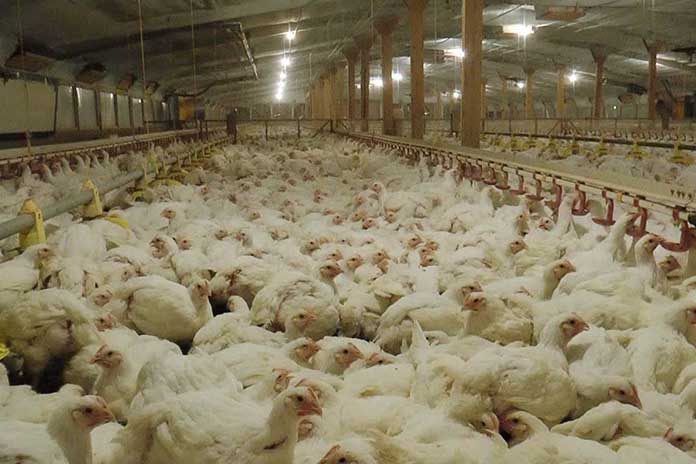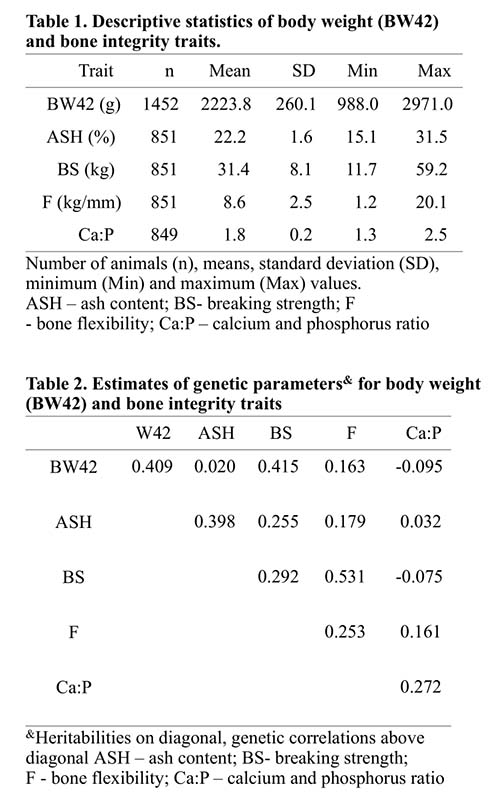
In this study, genetic parameters of important traits related to body weight and bone resistance were investigated in a paternal broiler line. Data from 1452 chickens slaughtered at 42 days of age were used. Heritability and genetic correlations for body weight at 42 days (BW42), ash content, breaking strength, flexibility, and Ca:P ratio were estimated. Analyses were performed using QxPak software with an animal model. The genetic parameters were estimated by restricted maximum likelihood. Results have shown considerable phenotypic variability in the broiler line studied. The selection for BW42 increased breaking strength and in a lower proportion tibia flexibility. The knowledge of the genetic parameters related to bone integrity traits could support breeding strategies to reduce leg problems in the poultry industry. Leg problems are multifactorial disorders in which the main determinant factor is the intense selection for rapid growth rates and heavy body weight. Leg disorders have become a major concern in commercial poultry meat production due to the negative impact on feed efficiency, growth performance, increased carcass condemnation and late mortality in broilers, and welfare problems (Whitehead et al. (2003); Julian (2004); Oviedo Rondón (2007)). Locomotor problems are not a recent production issue. Sullivan (1994) estimated the annual cost of leg problems to the U.S. poultry industry to be $80 to $120 million for broilers. In 1992, the UK’s Farm Animal Welfare Council (FAWC) declared leg problems to be a major welfare problem in broiler production. The poultry breeding companies have increased the intensity of selection against skeletal deformities (Pattison (1992)). However, the genetic progress achieved has been insufficient to reduce these abnormalities. Skeletal disorders have been one of the most prevalent production problems in the poultry industry and cause more economic losses than any other single abnormality in the chicken production (Day (1990); Knowles et al. (2008)). Despite its relevance, the genetic mechanism involved with this problem is not completely understood. The bone structure is closely related to leg problems in chickens. In this study, genetic parameters of important traits related to body weight and bone resistance were evaluated in a paternal broiler line. We expect that this information could support broiler breeding programs to find genetic strategies to reduce leg problems in poultry.
Materials and methods
Animals and data file. Broilers used in this study were from an experimental population generated by the expansion of a paternal broiler line TT, developed at the Embrapa Swine and Poultry National Research Center, Brazil. This line has been under multi-trait selection, with emphasis on body weight at 42 days of age (BW42). Twenty males were mated to 92 females (1:5) to produce 1600 day-old chicks from 5 hatches, half of each sex. Chickens were kept in collective pens until 35 days of age and then housed in individual cages for feed conversion evaluation. At 42 days of age, 1465 chickens were slaughtered and evaluated for performance, carcass, cuts, and bone integrity traits.
Bone integrity phenotypes
Bone integrity related traits evaluated in the tibia were: ash content (%), bone breaking strength (Kg), flexibility (Kg/mm), and Ca:P ratio. Samples were stored in freezer at -20 °C. Bone resistance analyses were performed in the texturometer TA – XTPlus Texture Analyzer ©Texture Technologies Corporation, using the 3-Point Bending Rig (HDP/3PB) with 5 kg load cell Heavy Duty Platform (HDP/90) (Everard, et al., 2007). Bones were positioned with their epiphyses resting on two supports spaced 40 mm. The breaking strength (BS) is the maximum stress that bone can withstand while being stretched before breaking and the flexibility (F) is the ratio between BS (Kg) and the bone elastic linear displacement (mm). The fragments generated after the breakdown were heated at 105 ºC for 20 hours to determine the tibia dry matter. After this procedure, bones were burned in oven at 550 °C for 16 hours for ash content determination. Ca and P were determined by atomic Absorption and Flow Injection Analysis (FIA), respectively.
Statistical analyses
Data were analyzed with a mixed model including the fixed effects of sex and hatch, and the infinitesimal and residual random effects, using the QxPak software (Perez-Enciso and Misztal (2004)). Estimation of genetic parameters was performed using the Restricted Maximum Likelihood (REML) method with a multi-trait animal model.
Results and discussion
 According to the standard deviations and the minimum and maximum values (Table 1), there is considerable phenotypic variability among individuals in this population, despite the selection applied in the breeding program since 1992. This fact is also evident with the existence of moderate heritability for the analyzed traits (Table 2). Body weight has been one of the main criteria for selection in broiler breeding programs. According to the genetic correlation estimates (Table 2), the selection for BW42 increased breaking strength and, in lower proportion, bone flexibility, with no much change in the content of ash and Ca:P ratio in the tibia. The skeletal status of poultry is traditionally assessed by histology and estimations of bone ash, occasionally supplemented by estimations of the calcium and phosphorus contents (Thorp and Waddington (1997)). Genetics is a major component of leg health issue in broilers. The variables analyzed here were just one part of the physiological equation modeling bone health. The genetic progress achieved for bone quality has been insufficient to reduce leg problems in poultry. One of the causes is that the intrinsic bone phenotypes are difficult to measure. It has been suggested that variation in mineral composition, such as differences in bone Ca:P ratio might also affect bone strength (Thorp and Waddington (1997)). In the present study, the genetic correlation (rg) between Ca:P and BS was low and negative (-0.075). However, the rg between Ca:P and flexibility was positive (0.161). Bone strength depends in part on the relative amount of mineral content and organic matrix (Boskey et al. (1999)). Flexibility, however, is more related to the flexible collagen matrix in the bone. Therefore, flexibility seems to be a more complete phenotype to represent the bone quality. It is expected that more flexible bones will respond better to stressors in the poultry production system than rigid bones. Bone mineral density (BMD), a key variable for bone integrity (Hester et al. (2004)), was not measured in this study. Unraveling the genetic correlation between flexibility and BMD could be very informative, because BMD can be evaluated in vivo. In broilers, little information is available about the normal variation of bone traits and their genetic parameters. Moreover, the relationship between the changes in mineralization and bone pathologies, and production stress factors with bone fractures, need further investigation.
According to the standard deviations and the minimum and maximum values (Table 1), there is considerable phenotypic variability among individuals in this population, despite the selection applied in the breeding program since 1992. This fact is also evident with the existence of moderate heritability for the analyzed traits (Table 2). Body weight has been one of the main criteria for selection in broiler breeding programs. According to the genetic correlation estimates (Table 2), the selection for BW42 increased breaking strength and, in lower proportion, bone flexibility, with no much change in the content of ash and Ca:P ratio in the tibia. The skeletal status of poultry is traditionally assessed by histology and estimations of bone ash, occasionally supplemented by estimations of the calcium and phosphorus contents (Thorp and Waddington (1997)). Genetics is a major component of leg health issue in broilers. The variables analyzed here were just one part of the physiological equation modeling bone health. The genetic progress achieved for bone quality has been insufficient to reduce leg problems in poultry. One of the causes is that the intrinsic bone phenotypes are difficult to measure. It has been suggested that variation in mineral composition, such as differences in bone Ca:P ratio might also affect bone strength (Thorp and Waddington (1997)). In the present study, the genetic correlation (rg) between Ca:P and BS was low and negative (-0.075). However, the rg between Ca:P and flexibility was positive (0.161). Bone strength depends in part on the relative amount of mineral content and organic matrix (Boskey et al. (1999)). Flexibility, however, is more related to the flexible collagen matrix in the bone. Therefore, flexibility seems to be a more complete phenotype to represent the bone quality. It is expected that more flexible bones will respond better to stressors in the poultry production system than rigid bones. Bone mineral density (BMD), a key variable for bone integrity (Hester et al. (2004)), was not measured in this study. Unraveling the genetic correlation between flexibility and BMD could be very informative, because BMD can be evaluated in vivo. In broilers, little information is available about the normal variation of bone traits and their genetic parameters. Moreover, the relationship between the changes in mineralization and bone pathologies, and production stress factors with bone fractures, need further investigation.
Conclusion
There is considerable genetic variability in the tibia traits evaluated in the TT broiler line. The BW42 is genetically more correlated to the tibia breaking strength than to the tibia flexibility. Nevertheless, flexibility seems to be a more adequate trait to improve bone quality.
References are available on request.
From the Proceedings, 10th World Congress of Genetics Applied to Livestock Production

















